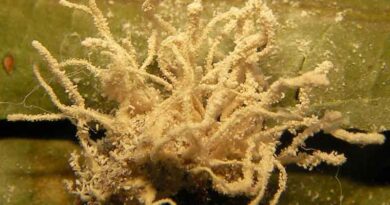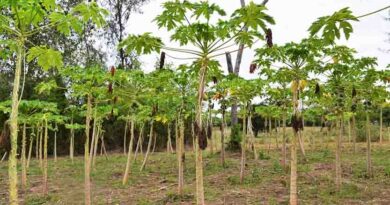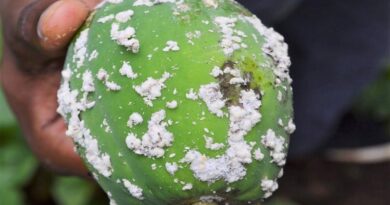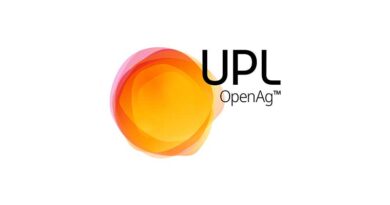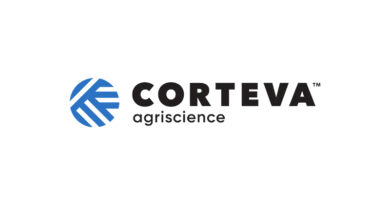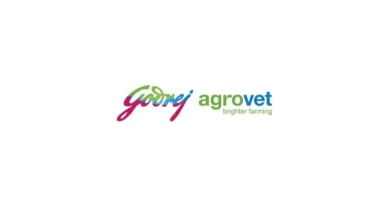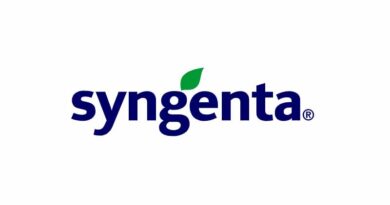Spread of highly invasive apple snail leads to rise in production costs for rice farmers
10 November 2021, Kenya: The invasion of the apple snail Pomacea canaliculata in Kenya is estimated to have led to an increase in production costs for rice farmers in Kirinyaga County with an additional Kshs 9,668,100 spent on 781 acres.
A field scoping exercise conducted by CABI – involving stakeholders including the Ministry of Agriculture, Livestock Fisheries and Cooperatives (MoALF&C), Capacity Development Project for Enhancement of Rice Production in Irrigation Schemes (CaDPERP), County Government of Kirinyaga, the National Irrigation Authority Mwea Irrigation Agricultural Development (NIA-MIAD), the Kenya Plant Health Inspectorate Service (KEPHIS), Plant Protection and Food Safety Directorate, Pest Control Products Board (PCPB), Agrochemicals Association of Kenya (AAK), International Centre of Insect Physiology and Ecology (ICIPE), local agrodealers and millers – determined that urgent action is needed to control the pest.
Kirinyaga County is the main producer of rice in Kenya and working with NIA-MIAD and other stakeholders, the scheme produces 110,000 metric tonnes (mt) of paddy rice annually whose net worth has an estimated value of Kenya shillings (Kshs) 7.7 Billion. The rice value chain also supports additional income generating activities e.g. hay balling, public and private millers and labour provision, among others.
The scheme is 26,000 acres, all under an irrigated rice crop that supports approximately 7,000 households directly. According to NIA-MIAD, plans are underway to add 10,000 acres to the scheme to boost rice production in the area.
Kirinyaga County is the main producer of rice in Kenya and Farmers grow their main rice crop from July to December every year, followed by a ratoon crop for two months.
Rice production in the county however faces a new threat-the invasive apple snail. The snail was first spotted in the Murubara River in February 2020 and confirmed using molecular tools by CABI, KEPHIS and NIA-MIAD in December 2020. Since then, it has spread primarily through irrigation canals and mechanised farming implements and is presently found in the entire scheme.
A Multi-Institutional Technical Team (MITT) on crop health set up by MOALF&C visited the affected when the pest was detected and spearheaded management efforts. Working with the County Government of Kirinyaga and NIA-MIAD and other stakeholders, technical information and management options were consolidated to advise farmers on how to manage the pest.
Weekly sensitization efforts were conducted across 68 units in the Mwea Irrigation scheme to enhance farmer awareness. This included scouting and monitoring activities aimed at tracking the spread of the pest within the scheme and preventing its spread to other rice growing areas in Kenya. The PCPB was also instrumental in conducting trials and fast tracking registration of products that could be used to manage the snail.
To build on these efforts, CABI conducted a one-day stakeholder workshop and focus group discussion with a group of 48 farmers from Mwea, Tembere, Thiba, Wamumu and Karaba sections of the irrigation scheme to assess farmers’ awareness/knowledge of the pest, the extent of the invasion, and management practices currently being used.
The findings from the scoping visit, stakeholder workshop and focus group discussions are expected to inform the design of a communication campaign targeted to increase awareness of effective management practices to control the pest in Kirinyaga, and potentially prevent its spread into other production schemes in Kenya.
David Onyango, Communications Specialist at CABI, and Rahab Njunge, Theme Officer – Development, Communication and Extension at CABI, in a report based upon the field scoping visit and stakeholder workshop, said, “The visit showed the urgency required in addressing the apple snail in Kirinyaga. While the pest has already spread to all parts of the Mwea irrigation scheme, the risk of transmission to other rice-producing areas in Kenya remains high. The release of a control product being tested by PCPB remains paramount.
“Management practices used in other countries could help in managing the pest. However, applicability will depend on the local context and the campaign needs to promote only what works for farmers in Kirinyaga County. For instance, while rotation with legumes may be helpful, farmers were unlikely to adopt the practice given the economic importance of the ratoon crop. The ratoon crop is highly regarded by farmers as it involves lower production costs and often helps to bridge both yield and income gaps experienced in the preceding season.”
A range of recommendations have also been proposed starting with a communications campaign targeting farmers, merchandised service providers and agrodealers in the affected and areas including rice schemes at risk.
Other actions in the near future include organising a National Stakeholder Forum to explore best practices from Asia and other parts of the world that might fit into the Kenyan context and raising the awareness on the need to adopt an Integrated Pest Management Approach (IPM) to managing the snails without an over-reliance on chemicals.


